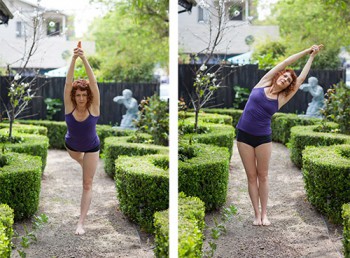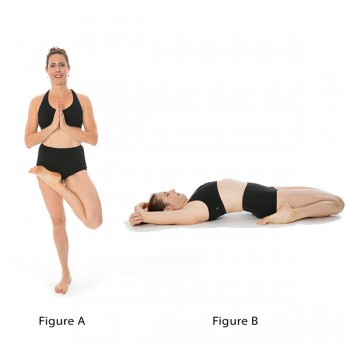Spine and Hips
It is staggering how many people have back pain. I am so excited to write about this fundamental because I think there is so much we can do to reduce and sometimes heal our own back pain. Back pain can develop early or later in life. It can be a slow and gradual problem that worsens over time, arises from overuse, or as a result of bad alignment throughout the body. When I made the connection between supporting the curves in my back with neutral hips, my back pain was virtually eliminated. (As long as I maintained my regular yoga practice.)
A lot of the concepts I will speak about in this blog post are much easier to show someone who is right in front of me. However, with this blog post along with my video, I hope you will get the information you need to connect to your own spine and hips and start connecting them to my other fundamentals to improve your alignment and physical connection. I believe the more you start making these connections, the better you will feel and the quicker you will strengthen and heal your body.
The Spine
It is so important that we make an effort to understand the curves in our spine to provide support and strength to our neck and back. If you look at someone from the side (it is a little hard on your neck to look at yourself from the side) you will notice the curves in the neck, the middle back, then the curve in the lower back and down to your sacrum and tailbone. All of us are unique and our curves have a slight variety. As Dr. Burnham says, standing up straight can look a little different for everyone. So we must learn and understand our own bodies to learn how our spine and hips need to work together to provide support.
Back pain is a big issue in our country, and there is no one size fits all cure. I do think that we are a society of impatience and we want our doctors to fix many of our problems with drugs and surgery. But one of the best ways to reduce back or hip pain, or most pain in the body for that matter, is to get up move and stretch. In addition, if you bring good alignment principles into your fitness routine, it can have a profound positive effect on your whole body and specifically benefit your back. Often people do not learn about alignment principles until they are in pain and miserable. Better to learn them now and prevent all that pain. But if you are in pain, empower yourself to understand these connections and see how much healing you can bring to your own body.
Back Pain and Starting to Stretch for Healing
 Years ago, when I was a teen, most people with back pain were just told to take pain meds and rest. (I remember my best friend’s mom taking pills and just going to bed from her back pain for days, and never really feeling better.) Back then few in the western medical world told people to stretch and back bend. (Bikram was a big early proponent of back bending to heal back pain, and he often says it was so revolutionary, people wanted to put him in jail.) It also helps to understand my alignment principles to reduce pain and increase function. Like everything else I talk about, don’t be afraid to start at the very beginning. Doing simple stretches up out of your spine, with your arms over your head demonstrated below as an example, can start to decompress and bring healing to the spine. It is never the depth that matters, but rather your form.
Years ago, when I was a teen, most people with back pain were just told to take pain meds and rest. (I remember my best friend’s mom taking pills and just going to bed from her back pain for days, and never really feeling better.) Back then few in the western medical world told people to stretch and back bend. (Bikram was a big early proponent of back bending to heal back pain, and he often says it was so revolutionary, people wanted to put him in jail.) It also helps to understand my alignment principles to reduce pain and increase function. Like everything else I talk about, don’t be afraid to start at the very beginning. Doing simple stretches up out of your spine, with your arms over your head demonstrated below as an example, can start to decompress and bring healing to the spine. It is never the depth that matters, but rather your form.
Connecting your Spine to your Hips
 I have combined the alignment of the spine and hips together because they are so connected. The pelvic bones connect to your spine at the back at your sacrum. (The sacrum is the last 4 vertebrates that are fused at the base of your spine.) So when you start to understand supporting your natural curves in your spine with a good core connection, the next step is to understand finding your neutral hips and applying them to supporting the curves in your spine. I realize your hips are not meant to always be neutral. They are a ball and socket joint and have many different range of motions to use and stretch. You want to use all of the ranges of your hips joints to keep them juicy and mobile. Tree pose (figure a) is a great pose for example to stretch your external rotation of the hips. I love this last photo of fixed firm (figure b) because you get a slight internal rotation of your hips in this posture, but you also get compression in your lower spine and an opening in your psoas and hip flexors in the front of the body.
I have combined the alignment of the spine and hips together because they are so connected. The pelvic bones connect to your spine at the back at your sacrum. (The sacrum is the last 4 vertebrates that are fused at the base of your spine.) So when you start to understand supporting your natural curves in your spine with a good core connection, the next step is to understand finding your neutral hips and applying them to supporting the curves in your spine. I realize your hips are not meant to always be neutral. They are a ball and socket joint and have many different range of motions to use and stretch. You want to use all of the ranges of your hips joints to keep them juicy and mobile. Tree pose (figure a) is a great pose for example to stretch your external rotation of the hips. I love this last photo of fixed firm (figure b) because you get a slight internal rotation of your hips in this posture, but you also get compression in your lower spine and an opening in your psoas and hip flexors in the front of the body.
2 Ranges of Motion
There are 2 ranges of motion I want to explain in relation to the spine. The first is neutral in terms of front and back and the second is neutral vs. turned out and turned in. First I suggest standing in a mirror to find your neutral hips. Stand in the mirror in tight fitting yoga clothes and turn to the side. Notice if you are either sticking your butt out or tucking it too far under. Play a bit by tilting your hips back and forth to find your neutral hips. I show an example of this in my video. Next, engage your core (Yogival Fundamental 2) and stand tall. (Pay attention that engaging your core does not move your hips.) I illustrate what I mean in the video – so pay attention.
The second range is turning in vs. turning out. To illustrate what I mean, simply stand with your feet hip width apart. Now touch only your toes together. That is turn in and that movement effects your body right up to your hips and lower back. Now, turn your toes out. Once again this movement in your feet affects your muscles and bones and joints right up to your hips and lower back. The reason I mention turn in vs. turn out is that one of the best things you can do for your back is some sort of back bending. Whether you are doing a simple cobra posture on the floor or standing back bend,
when you leave your hips neutral you can access more of your spine to bring healing instead of “crunching” into your lower spine. This is what most people do when they back bend because they are unaware of this alignment principle and connection. You will also see that these 2 alignment principles are relevant when you do push ups, sits ups or any fitness routine. Connecting and supporting your spine and hips also allows you to isolate other muscles in the body to bring strength, but also to bring more healing and ease to other parts of the body. (In the instance of a push up, the neck and shoulders are relaxed and not engaged while the legs, core, and back are strengthening) When you make the connection and understand how your hip joint is in relation to your spine, it can empower you to either work out harder at the gym without pain, start an exercise routine as simple as walking (great for back pain!) or to support and deepen your yoga practice. You may also pay more attention to how you stand to see if you stand in an awkward way that throws your body out of alignment.
Now start practicing connecting to supporting the natural curves in your spine and neutral hips, stand taller, feel better and walk with less pain in your day. I hope you will be able to combine what I’m talking about in this Fundamental with the visuals that I provide in my video. I encourage you to read this again after you watch the video to make a deeper connection with the content and to increase understanding. If you haven’t purchased my 5 Fundamentals Video Series you can do so here. Always feel free to reach out with any questions you might have with the contact form or on any of my social media channels.